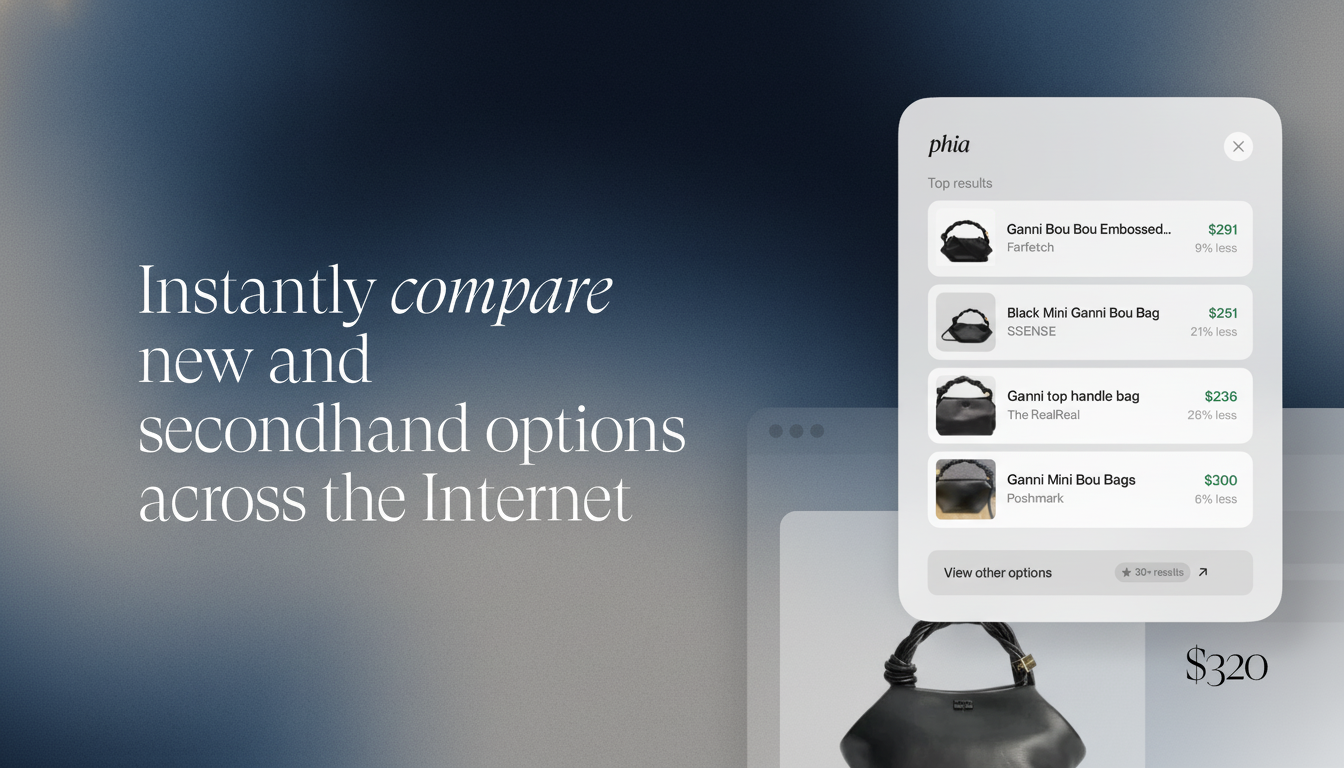The future Phia imagines is this: Online shopping rewired in real time, and the catalyst is not just generative text — it’s a stack of AI systems that understand taste, price, fit and resale value all at once. Their thesis is straightforward: If algorithms can sift a shopper’s intention like a veteran stylist and deal hound would, e-commerce could become more personal, more sustainable, and far more transparent.
AI Is Changing the Rules of Product Discovery
Phia began as a roommate project at Stanford and has grown into a browser extension and an app that reimagines how discovery works. Rather than asking users to conduct brand-by-brand searches, the company gathers results from retailers and secondhand marketplaces before using ranking models to surface items most likely to satisfy style, budget and timing preferences.

The founders say their system aggregates more than 350 million items and draws on over 150 secondhand platforms, which is important for both reach and coverage of pricing. Under the hood, vector embeddings associate product attributes (cut, color, materials) with user behavior as your feed gets better at showing items of interest based on how you save, click, and pass. It is the type of semantic search Google and Amazon have pioneered, but now it’s coming to the item level for fashion.
Industry momentum supports the thesis. Tens of billions in EBIT could be added through the application of AI — ranging from better merchandising, search and personalization, according to McKinsey. Adobe Digital Economy research also found that as recommendations become more relevant, conversion and AOV will follow.
Price Transparency Versus Resale Value Dynamics
Gates and Kianni are betting that “what is this actually worth” will become the new north star for online shopping. In Phia, a shopper considering a $500 bag can see what that style has recently sold for secondhand online; its “depreciation” average and likely exit price are also spelled out — say, between $300 and $400 if the brand tends to hold value — or a warning on whether a $100 fast-fashion piece typically falls to $10, a 90% plunge.
That evaluation combines historical listings, brand-specific longevity and demand indicators. The result is a Bloomberg Terminal feel for consumers: not just the lowest price today, but anticipated cost of ownership over time. It’s the level of transparency marketplaces have been whispering about for years, now wrapped into a pre-purchase nudge instead of a post-purchase regret.
Sizing And Fit Move From Guesswork To Signals
Fit is still the most expensive problem in the industry. Phia’s founders say their sizing forecasts — currently in beta — rely on previous orders and returns to predict, based on everything from brand idiosyncrasies, fabric stretch, or cut, if a piece will fit before you click buy. It’s a personal fit model trained on your history rather than generic size charts.
Peers in retail provide some proof that it can work. E-commerce giant Amazon has been adding machine learning-powered summary bullets atop written reviews that now show the key insights you need to know at a glance around fit and other considerations, and longtime players in the space like True Fit have proven out already that personalized recommendations can shave return rates materially. For consumers, fewer returns mean less friction; for retailers, the margin math gets inverted.

Sustainability As The New Default Shopping Filter
Phia doesn’t treat secondhand as another tab, but as a first-class consideration. Kianni points to one especially powerful data point: Buying a secondhand item can reduce its carbon footprint by about 80 percent compared with buying new when you factor in avoided production. That squares with the work of fashion sustainability researchers and lifecycle assessments that emphasize reuse.
The market tailwind is real. ThredUp’s annual Resale Report predicts that the US secondhand market will balloon to an estimated $70 billion within a few years, significantly outpacing traditional retail. The younger demographic of the buyers, in particular, thinks about things like resale value as part of the purchase decision, and that aligns well with Phia’s pricing and depreciation models.
Content And Community Serve As A Growth Engine
Rather than rely on paid ads, Phia created an ambassador network and a behind-the-scenes content stream, featuring a podcast.
Kianni says those channels have generated hundreds of thousands of cheap downloads by targeting shoppers in the areas where they already find trends — social feeds, creator-led shows, etc. — and putting a human face to it.
This strategy also reflects a more general change: in an AI world bristling with competitors, narrative clarity and founder availability count. Gates says that being open to unpolished, in-progress updates enabled users to connect with the team and mission, which is a “far cry from the theatrics of polished perfection many commerce apps put forth.”
What’s Next For AI-Powered Online Shopping Experiences
Then comes agentic shopping — systems that keep an eye on wish lists across the web, monitor price drops, consult your calendar and the weather forecast, and alert you only when the right item reaches the right price at the right size. And expect more multimodal inputs too: Upload a picture of a silhouette you love, and agents source similar fits across new and pre-owned inventories.
It will all come down to trust. Transparent claims about when AI is driving pricing, strong data privacy policies around purchase histories and body dimensions, and auditable claims of sustainability will separate the durable platforms from the novelty apps. So if Gates and Kianni are correct, it won’t seem like a scavenger hunt to fill up your digital shopping cart; it will feel more like conscious ownership — like the right discovery, price, fit and impact all being on one click-pushing page.

